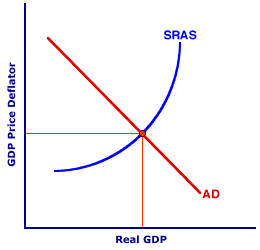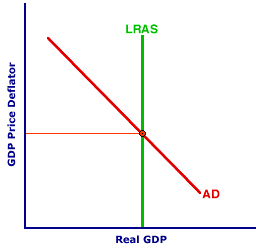
|
|
NONPRICE COMPETITION: A method of competition undertaken by firms in the same market (typically oligopoly firms) that involves advertising, brand-name promotion, support services, illegal activities, and everything but the price. Oligopoly firms are quite prone to nonprice competition due to the interdependence, especially such as that illustrated by the kinked-demand curve. Because oligopoly firms find difficulty competing through prices, they seek out alternative methods of competition, such as advertising or sabotage.
Visit the GLOSS*arama
|
|


|

|
                           SHORT-RUN AGGREGATE MARKET: A macroeconomic model relating the price level and real production under the assumption that SOME prices are inflexible, especially resource prices. This is one of two aggregate market submodels used to analyze business cycles, gross production, unemployment, inflation, stabilization policies, and related macroeconomic phenomena. The other is the long-run aggregate market. The short-run aggregate market isolates the interaction between aggregate demand and short-run aggregate supply. The key assumption of this model is that SOME prices, especially resource prices, are inflexible. The primary result of this model is that the economy can achieve short-run equilibrium at real production that is either greater than or less than full-employment. The short-run aggregate market is one of two submodels of aggregate market analysis. It builds on the assumption that some prices are inflexible or rigid in the short run. This notion of inflexible prices means that some macroeconomic markets--especially resource markets--have surplus or shortage imbalances even though other markets--product and financial--have achieved equilibrium.The distinguishing feature of the short-run aggregate market is a positively-sloped short-run aggregate supply curve. The short-run aggregate supply curve is positively-sloped in large part due to inflexible resource prices. In other words, as the price level changes, resource market imbalances mean that real production also changes. Full-employment is not guaranteed. Three Markets in OneTo be technically precise, the short-run aggregate market is the short-run aggregate "product" market. Including this extra term highlights the fact that the short-run aggregate market is the aggregation of the economy's product markets, markets that exchange final goods and services, or gross domestic product. However, two other aggregate macroeconomic markets, financial and resource, are also working behind the scenes of the short-run aggregate market.- Financial Markets: These are markets that exchange legal claims on physical assets. These financial instruments include stocks, bonds, banks accounts, and paper currency. Financial markets provide the liquidity (money and loans) that buyers use to purchase the production exchanged through product markets.
- Resource Markets: These are markets that exchange the services of the four factors of production--labor, capital, land, and entrepreneurship. Resource markets provide the inputs that producers need to produce and supply the output exchanged through product markets.
Short-run inflexible prices is most important for the resource markets. In the short run, rigid prices imply that resource markets are likely to be out of equilibrium. There are surpluses nor shortages in the resource markets, meaning there is cyclical unemployment or overemployment of resources. For this reason, equilibrium in the short-run aggregate market can arise when all two of the three aggregate markets--product and financial--are in equilibrium simultaneously, while the third aggregate market--resource--is not in equilibrium.The Graphical Model| The Short-Run Aggregate Market |  |
The exhibit to the right illustrates the basic components of the short-run aggregate market. Like any aggregate market model, the vertical axis measures the price level (GDP price deflator) and the horizontal axis measures real production (real GDP). The negatively-sloped curve, labeled AD, is the aggregate demand curve and the positively-sloped curve, labeled SRAS, is the short-run aggregate supply curve.Short-run equilibrium occurs at the intersection of the AD and SRAS curves. Inflexible resource prices mean that only the aggregated financial and product markets are in equilibrium at the intersection of the AD and SRAS curves. The resource markets are not in equilibrium. Because the SRAS curve is positively-sloped, short-run equilibrium can occur at ANY level of real production. It need NOT be full employment. To demonstrate that short-run equilibrium can occur at different levels of real production should aggregate demand change, click the [AD Increase] and [AD Decrease] buttons. An increase in aggregate demand leads to a higher price level AND an increase in real production. A decrease in aggregate demand leads to a lower price level AND a decrease in real production. Keynesian RootsThe roots of the short-run aggregate market can be found in Keynesian economics. While the aggregate market model has largely replaced Keynesian economics in the modern study of macroeconomics, the Keynesian proposition of inflexible prices is a cornerstone of the short-run aggregate market. Not surprisingly, the Keynesian economic implication of real production that is more or less than full employment is also implied by the short-run aggregate market.The Long-Run Alternative| The Long-Run Aggregate Market |  |
The short-run aggregate market is one of two submodels that make up aggregate market analysis. The other is the long-run aggregate market. The long-run alternative is based on the proposition that all prices, including resource prices, are flexible. Flexible prices give rise to a vertical long-run aggregate supply curve. Equilibrium in the long-aggregate market is achieved when all three aggregate markets--production, financial, AND resource--are in balance. Most important, there is neither cyclical unemployment or overemployment of resources.The exhibit to the right presents the standard aggregate demand (AD) and long-run aggregate supply curves (LRAS) that make up the long-run aggregate model. Most notable, the intersection of the AD and LRAS curve indicates equilibrium in the product (as well as financial and resource) markets. The equilibrium level of real production must correspond with the full employment of resources.

Recommended Citation:SHORT-RUN AGGREGATE MARKET, AmosWEB Encyclonomic WEB*pedia, http://www.AmosWEB.com, AmosWEB LLC, 2000-2025. [Accessed: June 30, 2025].
Check Out These Related Terms... | | | | | | |
Or For A Little Background... | | | | | | | | | | | | |
And For Further Study... | | | | | | | | | | | |
Search Again?
Back to the WEB*pedia
|



|

|
|
A lump of pure gold the size of a matchbox can be flattened into a sheet the size of a tennis court!
|

|
|
"I learned about the strength you can get from a close family life. I learned to keep going, even in bad times. I learned not to despair, even when my world was falling apart. I learned that there are no free lunches. And I learned the value of hard work. " -- Lee Iacocca
|

|
PRO RATA
According to the Rate (Latin)
|

|
|
Tell us what you think about AmosWEB. Like what you see? Have suggestions for improvements? Let us know. Click the User Feedback link.
User Feedback
|


|


